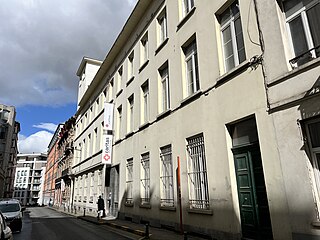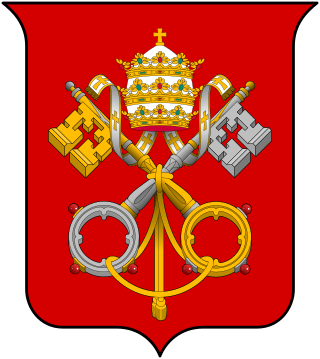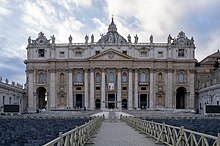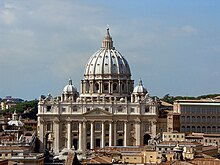The history of the Catholic Church is integral to the history of Christianity as a whole. It is also, according to church historian Mark A. Noll, the "world's oldest continuously functioning international institution." This article covers a period of just under two thousand years.
An episcopal conference, often also called a bishops’ conference or conference of bishops, is an official assembly of the bishops of the Catholic Church in a given territory. Episcopal conferences have long existed as informal entities. The first assembly of bishops to meet regularly, with its own legal structure and ecclesial leadership function, is the Swiss Bishops' Conference, which was founded in 1863. More than forty episcopal conferences existed before the Second Vatican Council. Their status was confirmed by the Second Vatican Council and further defined by Pope Paul VI's 1966 motu proprio, Ecclesiae sanctae.

The Italian Catholic Church, or Catholic Church in Italy, is part of the worldwide Catholic Church in communion with the Pope in Rome, under the Conference of Italian Bishops. The pope serves also as Primate of Italy and Bishop of Rome. In addition to the Italian Republic, two other sovereign states are included in Italian dioceses: San Marino and Vatican City. There are 225 dioceses in the Catholic Church in Italy, see further in this article and in the article List of Catholic dioceses in Italy.

Agostino Vallini is an Italian prelate of the Catholic Church. He has been a cardinal since 2006. From 2008 to 2017 he served as Vicar General of Rome. He is also the Archpriest emeritus of the Archbasilica of St. John Lateran.

Giovanni Coppa was an Italian cardinal of the Roman Catholic Church. He served as a diplomat of the Holy See, and was elevated to the rank of cardinal in 2007.

Caritas Europa is a European confederation of Catholic social service providers and international development and humanitarian relief organisations operating in Europe. It is one of the seven regions of Caritas Internationalis.
The history of the Catholic Church is the formation, events, and historical development of the Catholic Church through time.

The Diocese of Rome, also called the Vicariate of Rome, is a Latin diocese of the Catholic Church under the direct jurisdiction of the Pope, who is Bishop of Rome and hence the supreme pontiff and head of the worldwide Catholic Church. As the Holy See, the papacy is a sovereign entity with diplomatic relations, and civil jurisdiction over the Vatican City State located geographically within Rome. The Diocese of Rome is the metropolitan diocese of the province of Rome, an ecclesiastical province in Italy. According to Catholic tradition, the first bishop of Rome was Saint Peter in the first century. The incumbent since 13 March 2013 is Pope Francis.
The Council of the Bishops' Conferences of Europe is a conference of the presidents of the 33 Roman Catholic episcopal conferences of Europe, the Archbishop of Luxembourg, the Archbishop of Monaco, Maronite Catholic Archeparch of Cyprus, the Roman Catholic Bishop of Chişinău, the Ruthenian Catholic Eparch of Mukacheve, and the Apostolic Administrator of Estonia.
The Commission of the Bishops' Conferences of the European Union, formerly the Commission of the Bishops' Conferences of the European Community, is the association of Catholic Church episcopal conferences in member states of the European Union (EU) which officially represents those episcopal conferences at EU institutions. COMECE holds two meetings of the Plenary Assembly each year, which set out the main lines of its work. The Apostolic Nuncio to the European Communities participates in these meetings. A seminal issue of the European integration process provides the core theme of each meeting.
The following outline is provided as an overview of and topical guide to the Catholic Church:
Latvian Bishops' Conference is the national Roman Catholic Bishops' Conference in Latvia. It is headquartered in Riga and is a member of the Council of European Episcopal Conferences (CCEE) and the Commission of the Bishops' Conferences of the European Community (COMECE). It was founded as coordinator of the Latvian bishops on 15 November 1997, and held its inaugural meeting on 29 June 1998, starting off with a Pontifical High Mass in the Basilica of the Assumption in Aglona. Its first president was Cardinal Jānis Pujats, then archbishop of Riga.

The Romanian Episcopal Conference is the permanent assembly of Catholic bishops in Romania. The bishops' conference has its headquarters in Bucharest, is a member of the Council of European Episcopal Conferences (CCEE) and sends a representative to the Commission of the Bishops' Conferences of the European Community (COMECE).

Lithuanian Bishops' Conference is the official meeting of Catholic bishops in Lithuania. It has its seat in Vilnius. The Episcopal Conference is a member of the Council of European Episcopal Conferences (CCEE) and the Commission of the Bishops' Conferences of the European Community (COMECE).

Jean-Claude Hollerich, S.J. is a Luxembourger Catholic prelate who has served as Archbishop of Luxembourg since 2011. He was the president of the Commission of the Bishops' Conferences of the European Union (COMECE) from March 2018 to 2023. He is a member of the Jesuits.
Antonios Varthalitis, AA was from 1962 to 2003 Catholic Archbishop of the Roman Catholic Archdiocese of Corfu, Zakynthos and Cephalonia.
CIDSE, which is short for "Coopération Internationale pour le Développement et la Solidarité", is an umbrella organization for Catholic development agencies from Europe and North America.

Jesuit European Social Centre (JESC), formerly known as Catholic Office of Information and Initiative for Europe (OCIPE) is a research and documentation center on ethics and European integration founded in 1956.

Basilicas are Catholic church buildings that have a designation, conferring special privileges, given by the Pope. Basilicas are distinguished for ceremonial purposes from other churches. The building need not be a basilica in the architectural sense. Basilicas are either major basilicas, of which there are four, all in the Diocese of Rome, or minor basilicas, of which there were 1,810 worldwide as of 2019.

Mauro Gambetti, OFM Conv. is an Italian Catholic prelate who has served as archpriest of Saint Peter's Basilica, Vicar General for the Vatican State, and president of the Fabric of Saint Peter since 2021. He was consecrated a titular archbishop on 22 November 2020 just before Pope Francis raised him to the rank of cardinal on 28 November 2020.














